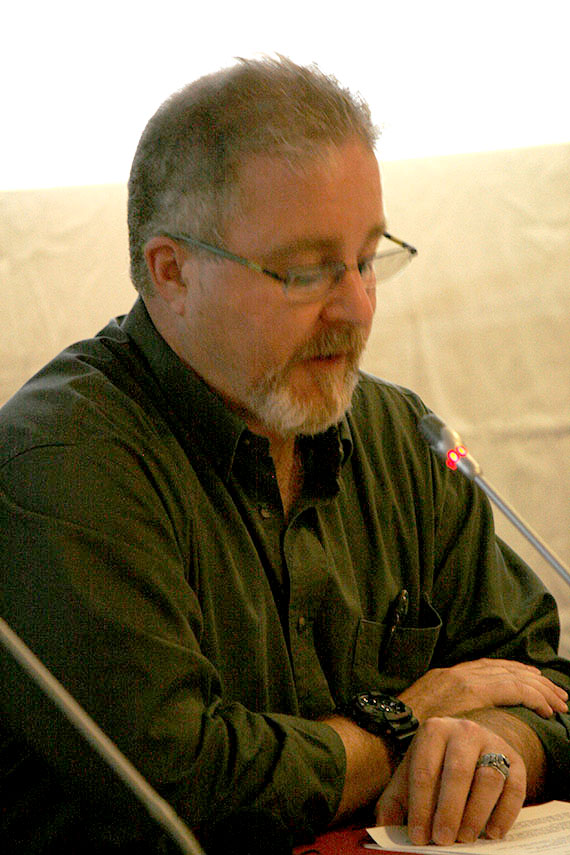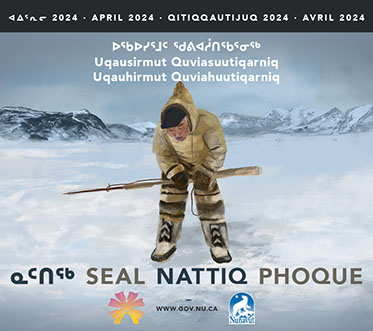Nunavut reps wrestle with DFO narwhal management scheme
Officials want plan approved ahead of March CITES meeting

Joseph Justus, DFO’s senior fisheries and aquaculture management officer, at a public hearing in Iqaluit this week organized by the Nunavut Wildlife Management Board. (PHOTO BY DAVID MURPHY)
Community representatives from around Nunavut are debating many issues related to a draft narwhal management plan that, if implemented, could affect Nunavut narwhal hunters in a big way.
Hosted by the Nunavut Wildlife Management Board, representatives from around Nunavut debated the draft plan at public hearings this week in Iqaluit, with the last discussions ending July 26.
The Department of Fisheries and Oceans developed the management plan in consultation with Inuit organizations like Nunavut Tunngavik Inc., hunter’s and trappers organizations, and regional wildlife organizations.
Many changes could be implemented for the harvesting of narwhal, starting January 2013, but the main talking point was the total allowable harvest.
Currently, the Nunavut-wide narwhal quota is 734, but under the proposed plan, the DFO recommends an allowable harvest of 1,280.
But at the same time, communities in east Baffin and northern Hudson Bay will see a reduction in allowable narwhal catches locally.
The narwhal management plan will come into effect if approved by the federal fisheries minister, after the NWMB finalizes the narwhal management plan and submits is recommendations.
“The Qikiqtaaluk Wildlife Board feels the word “conservation” is being abused, because there are over 90,000 narwhals in Nunavut and yet DFO is suggesting that there are conservation concerns without giving any credit to Inuit who have abided by the quota system for the past 40 years,” QWB chairman James Qillaq said at the meeting.
But the DFO does not think communities will restrict their hunting.
“The management plan is not restrictive, as this is the requirement to ensure proper effective management and control of the narwhal fishery and it is necessary to ensure the conservation of narwhal,” the eastern arctic director for DFO, Eric Kan, said in an email to Nunatsiaq News.
“The proposed plan has been developed jointly by co-management partners and have been consulted with communities,” he said.
The DFO established its total allowable catch from stock population statistics that go as far back as the early 2000s and, in the case of Somerset Island, 1996.
But the DFO wants to bolster its scientific knowledge for many communities in the future.
“For 2013-14, DFO is planning to conduct scientific research, combined with traditional Inuit knowledge research in Grise Fiord for Parry Channel, Jones Sound and Smith Sound stock,” Kan said.
The DFO will then conduct surveys on the Somerset Island and east Baffin Island stocks.
Another concern is the new three-tag system, which categorizes what communities can harvest at what point of the year.
This has been described as “confusing” by Qillaq and many others.
But the DFO senior fisheries and aquaculture management officer, Joseph Justus, said communities will have to warm up to it.
Three different coloured tags are designated for all-year, summer, or migratory catches when groups of narwhal are migrating around Baffin Island and often mix together.
The reason for the proposed summer and migratory stock tags is to ensure communities don’t accidently deplete any one specific stock migrating through the community’s area, most commonly in the High Arctic regions off Baffin Island.
Communities like Iqaluit and Pangnirtung will be able to hunt narwhal all year round, however, because of less-frequent narwhal activity near its waters.
It’s up to the 22 different hunting and trapping organizations to manage how many narwhal they want to hunt during a specific season to maximize its harvested stock.
Six new management units would each be allocated an amount based on total allowable catches. The tags would be given to HTOs to pass onto to hunters at the best times for harvesting.
If a community exceeds its total allowable catches, the total allowable catch would be decreased the following year, according to the management plan.
Public service announcements, which include brochures, would be distributed around Nunavut about the new changes, Justus said.
Justus also stressed that the draft can be modified as more information is revealed in consultations and as new data is released.
Other issues being debated at the hearings included:
• Permanent tags on narwhal tusks being traded nationally and internationally as part of a new “tusk trackability plan;”
• Greater responsibility on HTOs to distribute tags and record data from hunters;
• Not enough Inuit Qaujimajatuqangit demonstrated in the DFO plan;
• RCMP officers may have to regulate the plan if communities lack a conservation officer;
• The lack of scientific knowledge for stocks near Grise Fiord meaning only 20 harvests allowable for Parry Channel, Jones Sound and Smith Sound;
• Nunavik being left out of the recommended harvest levels of the northern Hudson Bay population.
The DFO says it’s important the narwhal management plan moves ahead quickly and be implemented by January 2013.
That’s because the Convention on the International Trade of Endangered Species is meeting in Thailand in March of 2013, and may then deem Nunavut’s narwhal trade harmful, and can impose international restrictions and bans.
The NWMB will send its final recommendations to the DFO minister in mid-August. After that, the DFO minister has 60 days to accept or reject the recommendations.
The last meeting is scheduled for 9 a.m. to 5 p.m. July 26 at the Arctic Hotel in Iqaluit, but may go over time. The meeting is open to the public.





(0) Comments